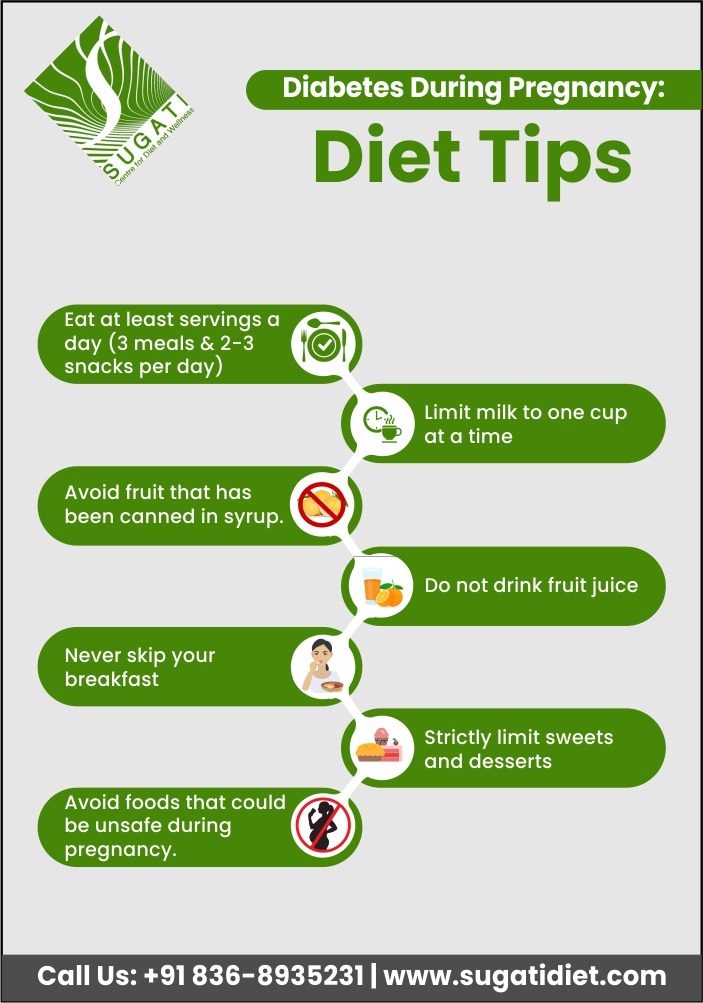
If you are pregnant and diabetic, it is important to keep an eye on the foods you eat, their quantity, and which foods to avoid or limit. You must plan your diet along with a dietician so that you have all the nutrients essential for your and the baby’s health, and at the same time, you can keep your blood sugar levels under control.
Diet for diabetes in pregnancy plays a vital role in maintaining your sugar levels by consuming more of certain foods, limiting others, and having meals at similar times daily and at specific intervals. We will, through this article, walk you through the different types of diets for diabetic pregnant women for a healthy you and your healthy baby.
Table of Contents
Feel free to skip ahead if one topic catches your eye:
- Gestational diabetes and your diet
- Diet for Type-1 diabetes in pregnancy
- Diet for Type-2 diabetes in pregnancy
- Which foods to skip
- Craving Sweet Foods and its link to Diabetes in Pregnancy
- FAQs
Takeaway
Gestational diabetes and your diet.
Diabetes developed during pregnancy is called gestational diabetes, which usually goes away after delivery. But it is important to keep it controlled to avoid complications. You must have more quantities of food having low GI (Glycemic Index). However, the glucose levels must stay within the targets.
Glycemic Index: GI is a value that measures the amount of increase in blood sugar by consuming specific foods. The lower the GI of food, the less it will disturb your blood sugar levels. The foods include:
-
- Fruits: apples, lemons, grapefruit, berries, etc.
- Non-starchy vegetables: carrots, spinach, tomatoes, broccoli, cauliflower, tomatoes, etc.
- Legumes: kidney beans, chickpeas, lentils, black beans, etc.
- Whole grains: oats, jowar, barley, ragi, quinoa, etc.
- Oils: olive, coconut, avocado, etc.
- Nuts: almonds, pistachios, walnuts, etc.
- Seeds: chia, flax, sesame.
- Chicken and fish
- Yogurt and low-fat milk and milk products: like cottage cheese
- Soya milk, coconut milk, and tofu
Distribution of food between 3 meals and 2-3 snacks helps keep your sugar levels in control.
Discuss with your dietician about the pregnancy diabetes diet chart for you and your baby’s good health and balance your blood sugar levels.

Diet for Type-1 diabetes in pregnancy.
Pregnancy with type 1 diabetes requires thorough dietary consideration and planning to cope with the changing nutritional and insulin needs. Customized diet planning and insulin adjustments are important as the needs vary according to your weight, activity level, food preferences, etc. Some important food for diabetic pregnant women are:
- Whole grains: like oats, millets, barley, quinoa, etc., are rich in fiber with low GI, helping in healthy bowel movements with lesser risk for increasing blood sugar.
- Green leafy vegetables and legumes: Beans, peas, spinach, corn, lettuce, broccoli, and lentils regulate blood sugar and provide proteins, vitamins, and minerals like folate and iron essential for you and your baby.
- Fruits low in sugar: Lemon, guava, green apples, oranges, etc., provide an adequate amount of vitamin c and have a low GI.
- Brown rice: has less GI than white rice and has more vitamins, minerals, and antioxidants.
- Soya chunks and eggs: egg whites, soy, and tofu are rich in proteins, and egg yolk has good fats for building up muscles and healthy development of the baby and does not increase blood sugar.
- Fish and chicken: They are protein-rich, and fish has omega-3- fatty acids that promote the baby’s brain health.
- Dairy products like yogurt, low-fat milk, etc., have a low GI and are rich in calcium for the baby’s healthy bone development and keeping your bones and teeth healthy.
- Fortified milk and fish are rich in vitamin D, which helps your baby’s bones, heart, kidneys, and brain to develop healthily.
- Beans, lean meat, spinach, etc., rich in iron, prevent the risk of the mother developing anemia and thus provide enough oxygen and blood to the growing baby.
This will help you eat well with diabetes in pregnancy without disturbing your sugar levels.
Diet for Type-2 diabetes in pregnancy.
When you are pregnant with type 2 diabetes, it is crucial to keep your blood sugar at normal levels, which can be possible by regular exercise and eating a well-balanced and nutritious diet. Do not overeat, “eating for two” doesn’t mean that you eat twice your diet. You just need some extra calories, ranging from 1700-2700 a day, which your dietician can plan. The food for diabetic pregnant women is the same as that for type 1 and 2 diabetes. Still, it has to be personalized for each individual according to her needs to manage pregnancy diabetes with a healthy diet.
Which foods to skip in the diet for diabetics in pregnancy?
These foods must be skipped or limited in the pregnancy diabetes diet chart:
- Processed and refined foods: Like white pasta, white rice, chips, processed cheese, etc., as they spike up the blood glucose levels.
- Unpasteurized milk and milk products: They may contain bacteria that may cause infection to you and your baby.
- Fish having high mercury: High mercury can cause harmful effects on the unborn baby’s brain.
- Sugary foods like sweet juices, cakes, desserts, etc.: These foods will drastically raise sugar levels.
- Do not have more than 200 mg of caffeine a day: It can increase your blood pressure and heart rate and lead to dehydration. They also cause harmful effects on unborn babies.
- Raw or semi-cooked meat, poultry, seafood, or eggs: When food is not fully cooked, harmful bacteria may cause infection.
- Artificial sweeteners and artificial and synthetic foods: Some may cause harmful effects on the unborn baby.
- Fried foods like French fries, fritters, or other fried snacks: Cause excessive weight gain and increase your sugar levels with hardly any nutrition to you and your baby.
- Alcoholic beverages: This can cause developmental abnormalities in the baby and even stillbirth.
Always seek your dietician’s advice and follow the diet plan to incorporate all nutrients needed for you and your baby, and at the same time, keep control over your sugar levels.
Craving Sweet Foods and its link to Diabetes in Pregnancy
Craving for sweet foods is normal during pregnancy, but when you already have diabetes, eating more sweets may disturb and spike up your sugar levels. This may be related to:
- Hormonal changes,
- Dietary restrictions and
- Increased sense of smell and taste.
Always try to satisfy your cravings with healthy substitutes like cake desserts with fruit desserts, sugared drinks with natural unsweetened fruit juices or shakes, etc.
Managing diabetes in pregnancy with a healthy diet and exercise will keep your sugar levels and weight at optimal levels.
FAQs
- Can all fruits be safely eaten with diabetes in pregnancy?
Some fruits that have a high glycemic index like ripe mangoes, overly ripe bananas, watermelon, etc. must be limited as they can spike up your blood glucose levels. Others like cherries, strawberries, apples, oranges, etc., have a low GI and can be eaten safely.
- What can be the complications if diabetes is not controlled during pregnancy?
Uncontrolled diabetes, be it gestational or type1 or 2, during pregnancy can lead to several complications like:
- Congenital disabilities
- Preterm delivery
- Large baby
- High blood pressure
- What is Pregnancy diabetes?
Pregnancy diabetes is called Gestational diabetes, which develops during pregnancy and goes off after delivery in women who did not have diabetes before pregnancy.
Takeaway
Sugati – Centre for Diet and Wellness headed by Dr. Bipasha Das, the best dietician in Delhi NCR, assures you of providing personalized, simple, and sustainable diet solutions and meal planning to achieve your goal comfortably without craving or starving.
Recent Post
Crafted by Webcreatore Digital Solutions LLP.






